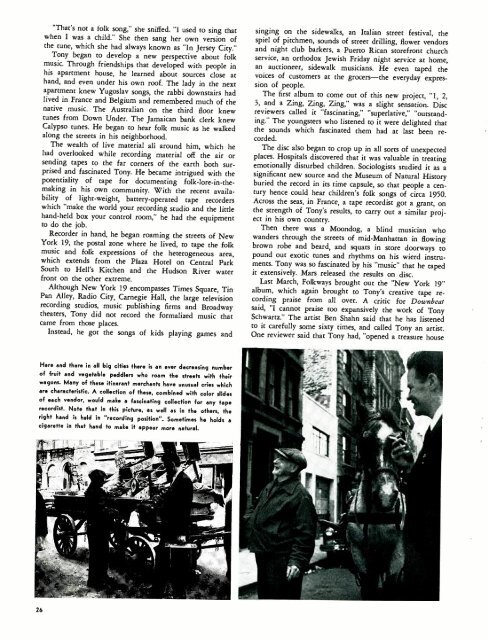Tape Recording Magazine - AmericanRadioHistory.Com
Tape Recording Magazine - AmericanRadioHistory.Com
Tape Recording Magazine - AmericanRadioHistory.Com
You also want an ePaper? Increase the reach of your titles
YUMPU automatically turns print PDFs into web optimized ePapers that Google loves.
"That's not a folk song," she sniffed. "I used to sing that<br />
when I was a child." She then sang her own version of<br />
the tune, which she had always known as "In Jersey City."<br />
Tony began to develop a new perspective about folk<br />
music. Through friendships that developed with people in<br />
his apartment house, he learned about sources close at<br />
hand, and even under his own roof. The lady in the next<br />
apartment knew Yugoslav songs, the rabbi downstairs had<br />
lived in France and Belgium and remembered much of the<br />
native music. The Australian on the third floor knew<br />
tunes from Down Under. The Jamaican bank clerk knew<br />
Calypso tunes. He began to hear folk music as he walked<br />
along the streets in his neighborhood.<br />
The wealth of live material all around him, which he<br />
had overlooked while recording material off the air or<br />
sending tapes to the far corners of the earth both surprised<br />
and fascinated Tony. He became intrigued with the<br />
potentiality of tape for documenting folk- lore- in -themaking<br />
in his own community. With the recent availability<br />
of light -weight, battery- operated tape recorders<br />
which "make the world your recording studio and the little<br />
hand -held box your control room," he had the equipment<br />
to do the job.<br />
Recorder in hand, he began roaming the streets of New<br />
York 19, the postal zone where he lived, to tape the folk<br />
music and folk expressions of the heterogeneous area,<br />
which extends from the Plaza Hotel on Central Park<br />
South to Hell's Kitchen and the Hudson River water<br />
front on the other extreme.<br />
Although New York 19 encompasses Times Square, Tin<br />
Pan Alley, Radio City, Carnegie Hall, the large television<br />
recording studios, music publishing firms and Broadway<br />
theaters, Tony did not record the formalized music that<br />
came from those places.<br />
Instead, he got the songs of kids playing games and<br />
singing on the sidewalks, an Italian street festival, the<br />
spiel of pitchmen, sounds of street drilling, flower vendors<br />
and night club barkers, a Puerto Rican storefront church<br />
service, an orthodox Jewish Friday night service at home,<br />
an auctioneer, sidewalk musicians. He even taped the<br />
voices of customers at the grocers -the everyday expression<br />
of people.<br />
The first album to come out of this new project, "1, 2,<br />
3, and a Zing, Zing, Zing," was a slight sensation. Disc<br />
reviewers called it "fascinating," "superlative," "outstanding."<br />
The youngsters who listened to it were delighted that<br />
the sounds which fascinated them had at last been recorded.<br />
The disc also began to crop up in all sorts of unexpected<br />
places. Hospitals discovered that it was valuable in treating<br />
emotionally disturbed children. Sociologists studied it as a<br />
significant new source and the Museum of Natural History<br />
buried the record in its time capsule, so that people a century<br />
hence could hear children's folk songs of circa 1950.<br />
Across the seas, in France, a tape recordist got a grant, on<br />
the strength of Tony's results, to carry out a similar project<br />
in his own country.<br />
Then there was a Moondog, a blind musician who<br />
wanders through the streets of mid- Manhattan in flowing<br />
brown robe and beard, and squats in store doorways to<br />
pound out exotic tunes and rhythms on his wierd instruments.<br />
Tony was so fascinated by his "music" that he taped<br />
it extensively. Mars released the results on disc.<br />
Last March, Folkways brought out the "New York 19"<br />
album, which again brought to Tony's creative tape recording<br />
praise from all over. A critic for Downbeat<br />
said, "I cannot praise too expansively the work of Tony<br />
Schwartz." The artist Ben Shahn said that he has listened<br />
to it carefully some sixty times, and called Tony an artist.<br />
One reviewer said that Tony had, "opened a treasure house<br />
Here and there in all big cities there is an ever decreasing number<br />
of fruit and vegetable peddlers who roam the streets with their<br />
wagons. Many of these itinerant merchants have unusual cries which<br />
are characteristic. A collection of these, combined with color slides<br />
of each vendor, would make a fascinating collection for any tape<br />
recordist. Note that in this picture, as well as in the others, the<br />
right hand is held in "recording position ". Sometimes he holds a<br />
cigarette in that hand to make it appear more natural.<br />
26
















